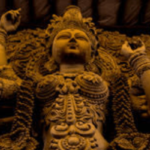Vṛttayaḥ pañcatayyaḥ kliṣṭākliṣṭāḥ.
- Vṛttayaḥ - mental modifications or activity
- pañcatayyaḥ - fivefold
- kliṣṭa – painful
- akliṣṭāḥ - non-painful
The modifications of the mind are five-fold and painful or non-painful.
Patanjali lists five types of thoughts (vṛttis) and describes them as painful or non-painful. Through the eyes of Śaivism, thoughts are nothing but contracted expressions of Consciousness. Śaivism uses the term ābhāsa to describe how Consciousness shines out its creation from its own formlessness. Think of how the sun shines out an infinite number of rays into the solar system, each ray extending to its maximum capacity and then dissolving back into the sun. So does Consciousness radiate an infinite number of ābhāsas that become our universe. Our thoughts are the ābhāsas of our limited Consciousness, shining out from our minds and forming our conceptual world of duality.
That which seems to hold our thoughts together is our ego, our small sense of “I”. As our thoughts arise from this relative sense of “I”, we feel separate from what we perceive and view reality from a perspective of duality. Thus, Śaivism states: Jñānam bandaḥ – knowledge is bondage. Knowledge that is dependent on our mental way of perceiving the world binds us to a limited, dualistic understanding of who we are. And due to our dualistic vision, what we experience is perceived as either painful or non-painful.
The distinction between painful and non-painful has profound implications for us psychologically. It means that when we see the world through our thoughts, we divide it into things we like (not painful) and those we don’t like (painful). In truth, everything in our world is a manifestation of divine Consciousness. Yet when we experience reality through the lens of our likes and dislikes, we fail to accept reality as it is, both inwardly and outwardly. In Jungian terms, when we find something within that is painful, we push it away and create a shadow within ourselves, a part of ourselves we reject. We end up diminishing our full sense of Self and undermine our ability to experience the fullness of life. So too do we project what we don’t like onto the world as something external to reject. Our lives often progress as a series of moves to avoid what we fear will be painful and attract what we hope will be pleasurable. Painful and pleasurable is a fundamental dichotomy in how we experience our reality. Although it has relative truth, it obscures our innate freedom to be open to ourselves as we are and our world as it is.
Exercise
Sit in a meditative posture and begin to watch your breath rise and fall. Keep focusing on the breath until you notice that your thoughts have slowed down. Now place your attention on an individual thought that arises. Don’t become engaged with its content, but carefully observe it. Thoughts are either pleasant, neutral, or painful. Experience any emotions that are attached to your thought. Carefully examine your thoughts as they arise and identify those which bring pleasure, those which bring discomfort, and those which are neutral. Then observe how stories arise from each type of thought.








